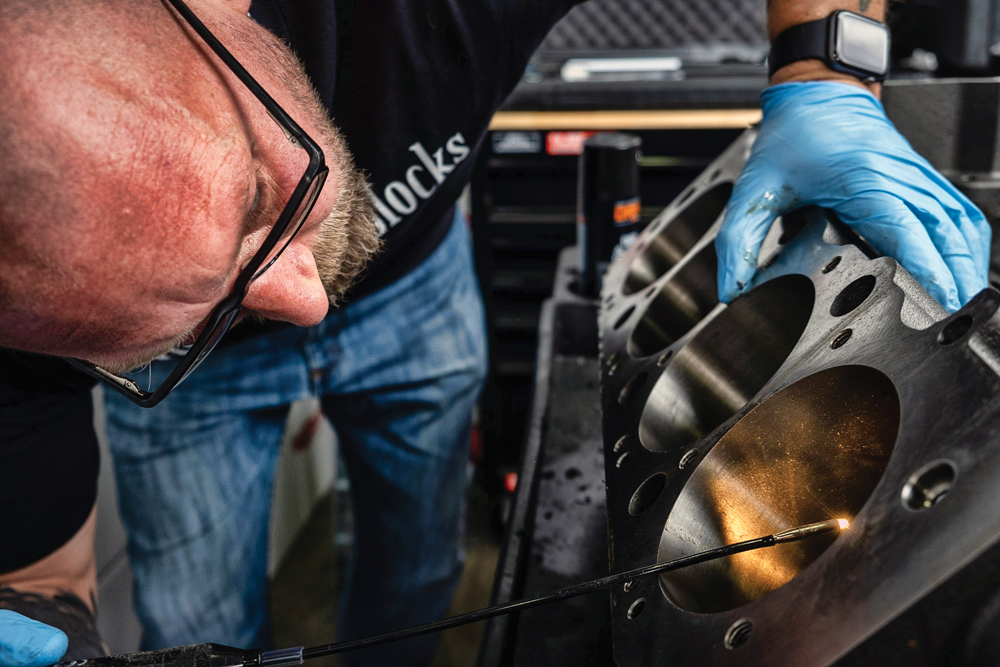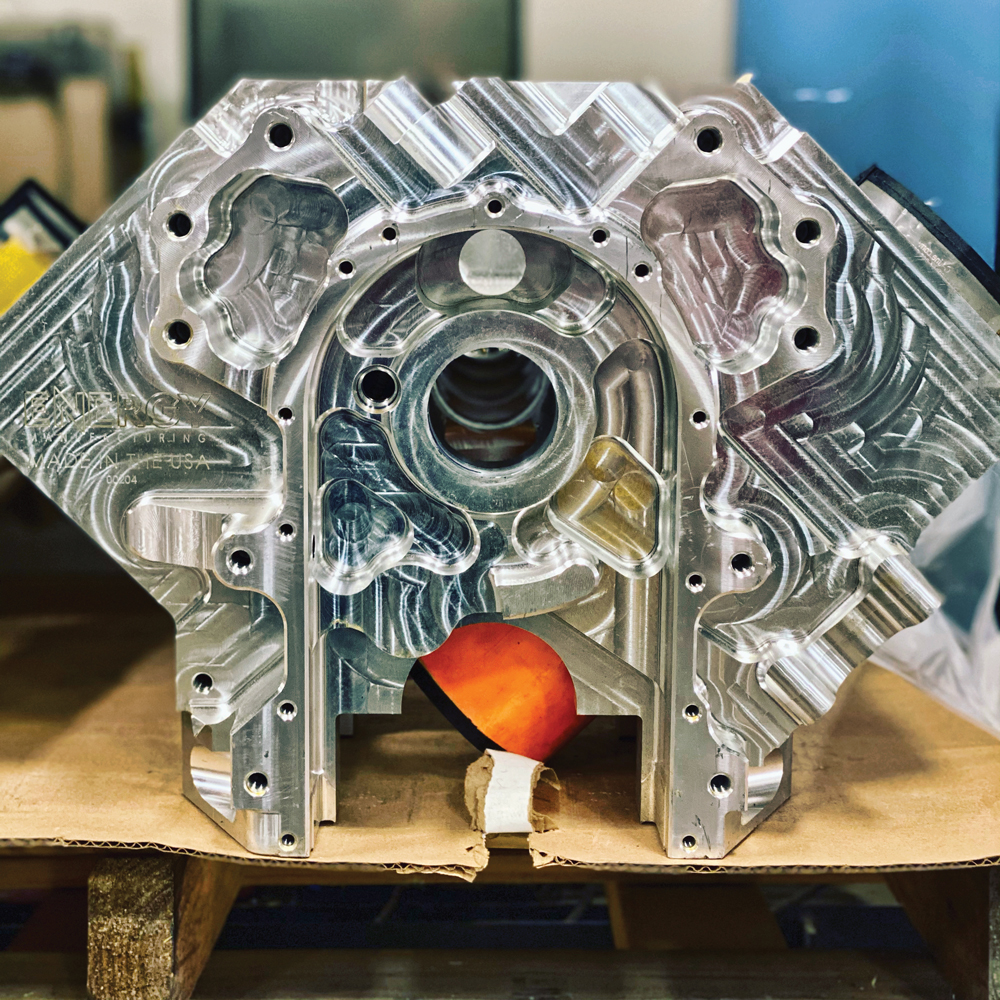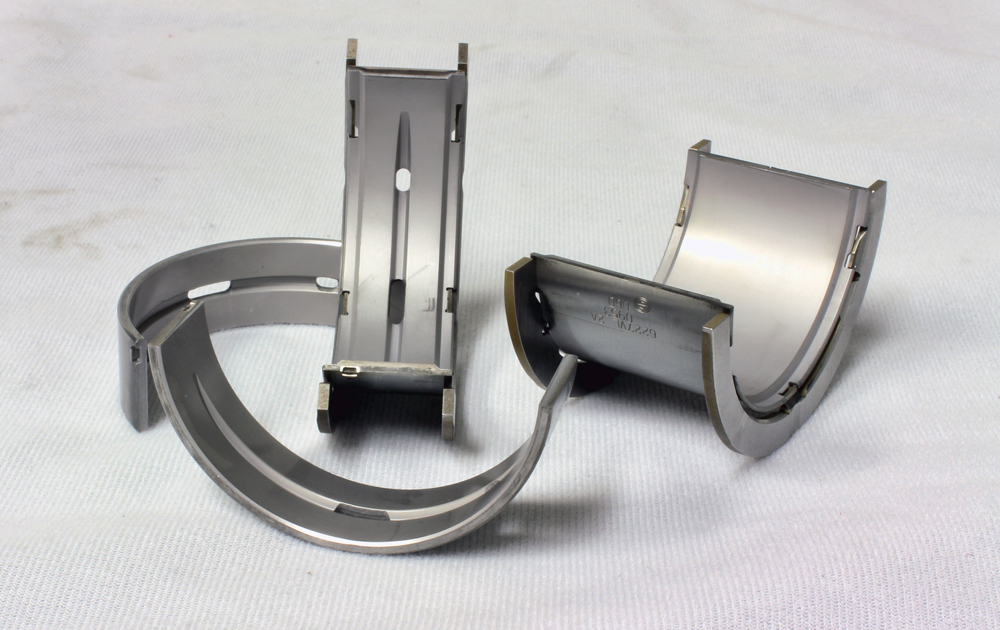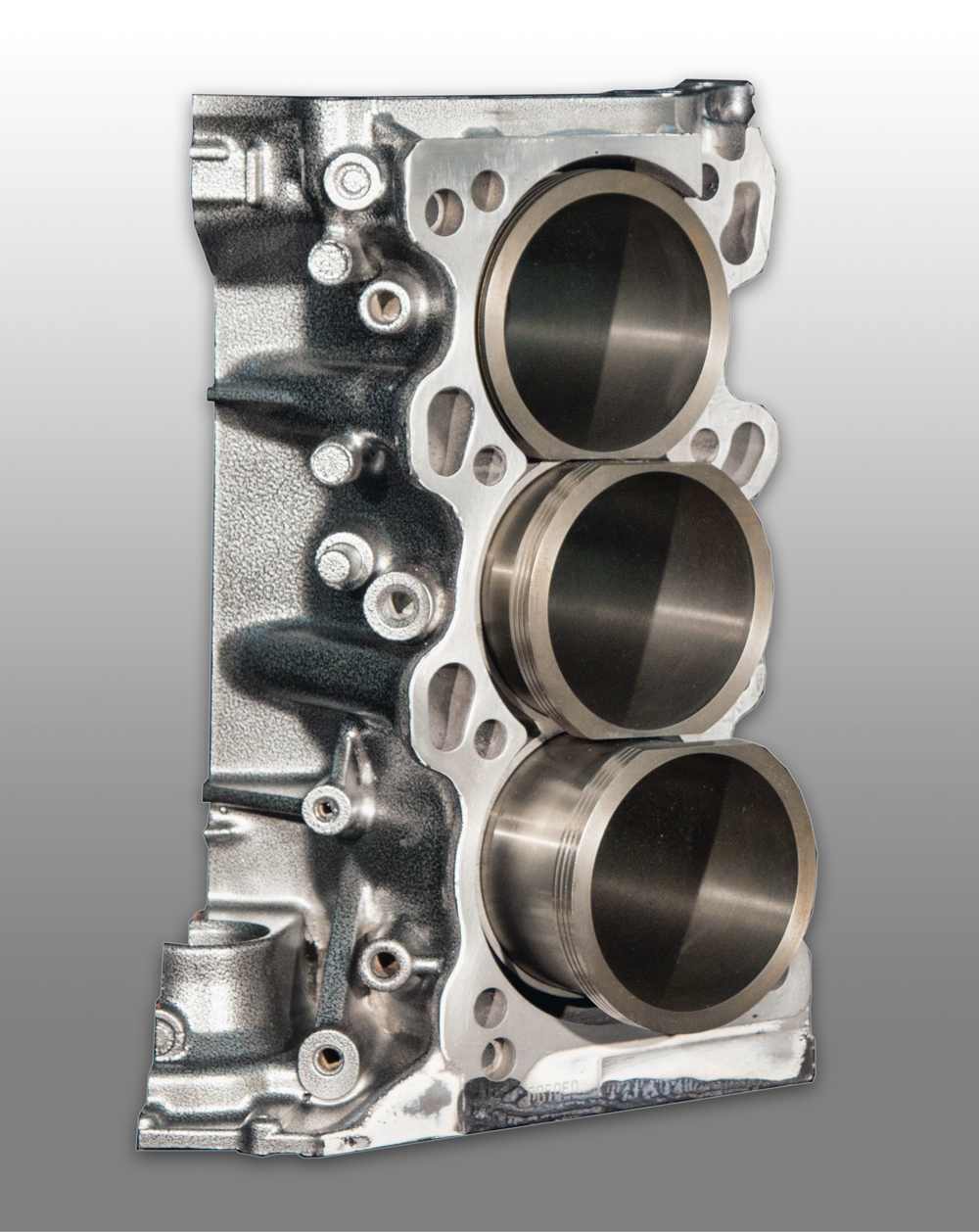Blockbuster Developments
Discover how manufacturers of cylinder blocks and related components are tapping into their collective creativity by expanding applications and experimenting with never-before-tried concepts.
For as long as anyone can remember, racers have pleaded with cylinder block manufacturers to make their products stronger, lighter, and less expensive. And many of the new blocks released in the last few years have delivered on those requests. At the same time, however, some dedicated designs are also helping unleash horsepower by correcting and improving valvetrain dynamics.
Tricks like raising the camshaft location and manipulating the lifter-bore locations are alleviating some valvetrain geometry problems when combined with a complementary cylinder head. For example, Dart Machinery recently teamed with Proline Racing to develop a big block Chevy cast-aluminum cylinder block with a number of features that “straighten out the valvetrain” and eventually will be part of a complete and economical power package for sportsman racers.
“We retained the big block architecture but repositioned the valvetrain to work with Dart’s 20X asymmetrical cylinder head,” explained Mike Sanders of the Warren, Michigan-based company.
At Alan Johnson Performance Engineering (AJPE) in Santa Maria, California, the raised-cam Hemi block is making headlines in Pro Mod and select outlaw drag racing classes.
“Raising the cam allowed us to straighten the pushrod angles and shorten the pushrod lengths,” said Rick Wilkinson. “A lot is predicated on what you’re doing with the cylinder head. You want to let the engine run at higher speed and still maintain valvetrain stability. This is a move in that direction.”
More displacement is often on a racer’s shopping list—especially when rules allow unlimited bore and store—and Mena, Arkansas-based Brodix is helping loyal small block Chevy enthusiasts build 500-plus-cubic-inch engines with a new block that can be machined with either 4.400- or 4.500-inch bore centers. This block also comes with a 5.150-inch crank-to-cam centerline distance, which is the same as a big block Chevy.
“It uses a standard big block Chevy front drive, and it comes with a 10-inch deck height,” said Mark Fretz. “It’s one of the most popular items we have right now. We offer multiple lifter locations and layouts, depending on the cylinder head used.”
Driving much of this new development in cylinder blocks is the small-tire, outlaw drag racing segment, where engine builders have freedom and there are plenty of classes to spur unconventional thinking. That’s why Brodix is offering a choice between the two bore centers for small block racers.
“It all depends on the class,” said Fretz. “Those with the 4.500-inch bore spacing may have to carry more weight. This block is for large cubic-inch classes where they require a cast engine block.”
With a maximum bore of 4.250-inch available on the 4.500-inch-bore-center block, total displacement upwards of 524 cubic inches is possible. Fretz said a 4.200-inch bore combined with a 4.500-inch-stroke crankshaft is 498 cubic inches and will allow racers to compete in classes with a 500 ci limit.
“And they get the weight break for using a small block platform,” he added.
The block’s development was spawned by a request from an engine builder who asked just how high Brodix could raise the camshaft. The first attempt raised the crankshaft-to-cam centerline distance .434-inch because there was a cam drive available at that height. A Brodix machinist then wanted to try mixing up and modifying a few patterns at the foundry and ended up matching the BBC front drive on a small block foundation. That raised the cam a total of .629-inch.
A prototype block was cast and sent to the engine builder, who assembled an engine for test runs.
“It did well at the track, and he ordered five more,” said Fretz, noting that when other racers and engine builders discovered the block, more orders followed.

It’s easy to see how racer feedback, especially from the drag strip, is spurring block development and innovation these days—and how the blocks are being built to suit racers’ specific needs. The AJPE raised-cam Hemi, for example, was designed without the traditional inner head studs.
“This allows the user to take off the head without removing the intake manifold,” said Wilkinson. “That can really speed up time in the pits.”
The main selling point for the AJPE billet block is the camshaft location that’s raised .650-inch over stock. This allows longer stroke crankshafts and beefier connecting rods that won’t interfere with the camshaft. Racers also expressed concern about unwanted harmonics due to camshaft flex. Not only does the new block allow for a robust 70-mm cam core, but AJPE engineered a sixth cam bearing in the front section of the block for more camshaft stability.
The new Dart BBC block took a slightly different development approach, in that it was a direct collaboration with the engine-building shop of Proline Racing in Ball Ground, Georgia. The eventual goal is to create an affordable, high-horsepower boosted platform that can be used in a variety of sportsman drag classes. Key to the foundation is the new BBC block and the Dart 20X cylinder head.
“For this head, we created a one-piece rocker stand with the correct geometry, so you don’t have to use offset rocker arms,” said Sanders. “We also moved the lifter bores to straighten out the pushrods. It allows a 9/16-inch exhaust pushrod and a half-inch intake pushrod.
“You have to run a different cam core with the 20X, but it straightens everything out,” said Sanders, noting that changes to the block also helped design a more efficient cylinder head by moving the pushrods slightly away from the head. “We could then manipulate the turns in the intake port to get a better line of sight to the valve.”
The block is available in iron or aluminum with +.400-inch cam location, or it can be ordered in billet with a 1.000-inch raised cam. Proline Racing has already tested engines making 2,500+ horsepower at 9,200 rpm with the new combination.
Dart also revised its small block Ford lineup for 2021, eliminating the Sportsman line and updating the Iron Eagle with six-bolt cylinder-head mounting capability so it could support a SC1-style head. The oiling system was also revived. Finally, Dart changed the tooling so the lifter angles could be rolled to upwards of 47 degrees.
Small block Ford popularity is also driving sales at World Products in Louisville, Kentucky. Jack McInnis said success on the track is one motivating factor.

“We’ve been having a hard time keeping it on the shelf,” he said, adding that all the blocks are cast and machined in the United States and come standard with ARP fasteners. “A few people have won with it in racing, and word has gotten around.”
The small block Chevy remains the sales leader at World Products, though, especially since so many dirt tracks and sanctioning bodies require iron blocks.
“The small block Chevy platform has been the staple of hot rodding for a long time. People are familiar with them, and like everything else, they are cranking more and more horsepower out of them,” said McInnis, noting that cylinder head development continues to drive block sales. “Plus, people are figuring out how to make things work with power adders.”
Then there’s the most savage racing environment for a cylinder block—Top Fuel—where Energy Manufacturing of Fremont, Ohio, is making headway. Already offering billet aluminum blocks for the Chevy big block, LS, and Ford small block platforms, Energy is working with a leading Top Fuel team to produce a new block that can also be adapted to Top Alcohol. Energy has some traditional Hemi experience by producing cast iron Hemi and Wedge blocks for sister company Callies.
“The nitro block is still in testing, but we’ll have it fully launched this year,” said Heath Norton. “It’s a complicated piece because it has to endure hell. We did some basic prototypes to try out new concepts. Some worked, some didn’t, and we learned a lot from that.”
Energy’s goals were to add strength in areas that were traditionally weak and help reduce main bearing problems. As per the rules, designers couldn’t play with certain dimensions or features, such as lifter-bore locations.
“You can get a lot more creative outside of the Top Fuel world,” said Norton. “We added rigidity to reduce movement in the main-bearing bore. It is what it is, and once you get it approved you don’t change it.”
“As far as durability, Top Fuel is the most brutal environment you can put a block into,” agreed Wilkinson, noting that AJPE has updated its Top Fuel offering, too. “We’ve made improvements over last year, going to a four-bolt main, which has improved crankshaft life.”
Energy is also offering more options with its billet line. The BBC block can be ordered with plus .400- or plus .600-inch raised camshaft location, and it’s available with deck heights from 9.800- to 10.600-inch.
“The key thing is that we don’t build to order,” Norton explained. “We build to inventory, so we can pretty much deliver a block in 30 days.”
For the small block Ford, deck heights of 9.750-, 10.000- and 10.200-inch are offered. It also comes with a GM bellhousing pattern for ease in hooking up popular transmissions.
“It has the stock bore spacing, so you can pretty much run it in X275 or Pro 275, Limited Drag Radial—it can be utilized in a lot of classes,” Norton told us.
For the foreseeable future, continued power gains will require stronger blocks, and cylinder-head designers will likely seek out more help in aligning the valvetrain geometry to their specifications.
“Everything is growing in power,” Fretz said. “What used to be a highly specialized small market is becoming a much larger market because technology, fuel systems, and tuning management is making it easier.”
Bearing Capabilities
Top Fuel and Funny Car teams can download a treasure trove of information from the data recorder on the car, but another useful indicator of the nitro engine’s performance are the main and rod bearings, simply because they last only one run down the strip.
“The measuring tool of how that engine operates is how much compression that bearing measures after it comes out of the engine,” explained Dan Begle of MAHLE Aftermarket, Farmington Hills, Michigan. “They see how much the upper bearing crushed, and that dictates how good that cylinder was or how bad that cylinder was.”

Nitro racing, however, is in a universe of its own when selecting bearings. That’s why MAHLE offers four lines of bearings with the H and V series serving as the most popular for most avenues of competitive racing.
“The V is a lead-indium overlay and is used strictly on high-end horsepower engines. The H bearing is a copper-tin-lead overlay and is used on a variety of performance engines, high-end street cars and bracket motors,” said Begle. “If you’re looking to make a lot of horsepower, you need the V for the conformability of the bearing. The H is a harder bearing. It’s going to have more service life. So it depends on what the customer is doing.”
Basically, the V bearing would be more beneficial on a high-maintenance engine where the pan is pulled often for inspection and the bearings are replaced as needed. The H bearing was designed for NASCAR, so endurance is a priority.
“The H bearing is harder and is going to get more service life, but it is not as forgiving if you have major crank flex like you would have in power-adder engines,” added Begle.
Also helping the Top Fuel and Pro Mod teams with their bearing issues is Calico Technologies. The Denver, North Carolina-based firm developed a new CT-11 coating just for big-horsepower engines.
“Twenty-five-hundred horsepower is probably as low an application that we would put them in,” said David Adams.
Most engine builders are familiar with Calico’s CT-1 dry lubricant film coating that is a popular option on main and connecting-rod bearings for suppliers such as ACL and MAHLE. But Top Fuel and alcohol teams approached Calico two years ago seeking additional protection. Engineers traveled with and tested the new formulation with teams.
“Everything is so sensitive in those engines. You wouldn’t think so with 11,000 horsepower. CT-11 a totally new formulation with some of the same elements as CT-1 but the binder is totally different,” said Adams, noting that engineers continue to analyze feedback as more teams test the new compound. “Everyone who has used it has liked it.”
Controlling lubrication at the bearing is something Farmington Hills, Michigan-based Daido Metal addresses with its performance bearing. “We use a process called multi-boring that eliminates a huge oil leak at the main bearing,” explained Dusty Kull. “In certain applications, especially NASCAR, IndyCar, Formula One, where they’re trying to get every ounce of power and efficiency out of these engines as they can, being able to cut those oil leaks at the main bearings and reduce parasitic power loss is a big deal.”
Traditional bearing geometry has a crush relief—basically extra machining near the parting line. When the oiling hole in the crankshaft passes by the relief, oil can spill out of the bearing. Deep boring profile at the parting line and a continuous surface assure the oil film is maintained in that area.
“Our design and manufacturing method eliminates the crush relief safely without the risk of parting line contact, and [it] also reduces the leak,” said Kull. “We’ve had guys running dirt late models and sprint cars where they’ve been able to reduce oil viscosity just by reducing the leak at the main.”
The technology is also being adapted to the connecting rod bearing for select engine builders who are “really concerned about oil consumption inside the engine.” For that, Daido uses the lead-indium inlay material on the tri-metal configuration.
“A lot of guys recall the old Vandervell bearings, which are similar to lead-indium,” Kull added. “It offers superior performance to lead-tin-copper in most cases through embeddability and conformability—which are very important for performance engines.”
Reducing oil loss is also a priority at Grand Rapids, Michigan-based ACL. “Race teams are looking for every bit of horsepower they can get,” said Dennis Fox, noting that an LS bearing set offers short groove in the lower main bearing as an alternative to 3/4-groove design. “The short groove will minimize oil usage/loss and save horsepower resulting from an upgraded oil pump.”
Fox also told us that durability and precise specs across every set is now a common request from racers. The company recently worked with Pat Musi Racing of Mooresville, North Carolina, to come out with a narrowed version of the GM big block main set, and there’s also a line of Calico Technologies-coated bearings available for domestic and import applications.
Liner/Sleeve Solutions
Top Fuel and Funny Car teams go through numerous iron cylinder-block sleeves during a season, but with the cutback in drag racing during the 2020 season due to COVID-19, business was a little slow in that segment for Darton Sleeves in Carlsbad, California. The company used the lull to bulk up on inventory and service its customers, as well as seek out new opportunities.
“We make a piece of pipe, and it is hard to romance a piece of pipe,” quipped Dave Clinton. “We have engineered patented products over the years, which are very stable for us, like our MID (Modular Integrated Deck) kits and Seal Tight technology. The new products that we develop are the direct result of what goes on in the industry.”
Servicing damaged GM LS and Ford Coyote engines in 2021 has spiked by some 200% over last year, according to Clinton. OEM blocks with spray-on coatings often cannot be repaired, so sleeves are the only solution.
“For a company like us that specializes in the performance industry, that is where we see the growth. Now, from the standpoint of new products, look at the pinnacle of our product category: Top Fuel and Funny Car,” said Clinton. “For us, they set the bar with the performance standards that we have to live up to. So the rest of our customers benefit from the improvements, strength, and the reliability that we build into the Top Fuel and Funny Car sleeves.”
Steve Demirjian of Race Engine Development (RED) in Oceanside, California, works closely with Darton to install the MID system on a variety of blocks, including first-time efforts in powersports
“I just did a Polaris ATV and now I’m working on a three-cylinder Can-Am motorbike,” said Demirjian. “There seems to be a lot of people interested in powersports.”
Beyond designing the fixtures for these small engines, very little in the tooling or machining methods to facilitate MID installation has changed over the years.

“Most of the car blocks are mounted on a 2-inch bar on the machine. You cannot do that with anything smaller,” said Demirjian. “The crankshaft bores are so small on these engines, I had to make up smaller fixtures to get them on the machine table.”
The unique MID conversion basically turns a dry liner engine into a wet liner, so there is considerable machining to open up the block and position the liners. The process also converts an open deck into a closed deck design. The limiting factor for eligible MID conversions is that the head studs must anchor in the lower part of the crankcase.
“That represents about 80% of the blocks manufactured today,” said Clinton. “The MID kit makes the structure more stable and allows the engine to make more horsepower without distortion, and more importantly, without leakdown. A typical dry-sleeve block, even in the best of circumstances, has a leakdown of 6% or 7%. Most of our MID blocks are 1% or 2% or less, so it is a big factor for us.”
The COVID slowdown helped L.A.Sleeve in Santa Fe Springs, California, work with a new material that shows promise. “It’s a ferrous-based material that is as strong as a ductile iron, but is lighter,” said Dave Metchkoff. “The material’s surface, for lack of a better description, has more lubricity than ductile iron. We’re testing it now with some engine builders. It is a really cool material.”
With the new material, the sleeves are not manufactured the same way. Metchkoff said it’s extruded and was developed for NASA. Now the supplier is testing the automotive market.
“We’re talking 14,000- to 20,000-rpm type of high-performance race motor,” added Metchkoff. “It has been used in F1 motors. We have also produced some drag race sleeves for compact cars.”
As with other aftermarket companies whose sales have increased over the past 12 months, L.A.Sleeve was challenged to produce product for unusual engines that were pulled out of the garage.
“We’re talking motor builds that are just out of nowhere,” said Metchkoff. “People are pulling projects out that they were waiting to get to for years. I am doing a motor for a compressor. It is a single-engine motor that uses a compressor and then a single-cylinder gas-burning motor. They work together. It is from 1895 and called an American Kellogg. It is just the craziest thing. Mercedes Gullwing: We have not done one in 15 years. It’s so interesting the amount of different projects we’re seeing. So, it has been great because we are grateful for any business we can get, but it has been incredibly stressful because we just have thousands of single, like one-off type of projects. So, it’s high stress. It has been one heck of a year for us.”
Gen III Hemi Block Set To ‘Change The Game’
Currently there are no Gen III Hemi engine block options in the aftermarket besides the Mopar Performance offering. But Dart Machinery of Warren, Michigan, has a fresh design with poured prototypes and a dedicated machining program underway. As of early spring, the company was just waiting on additional castings to complete its validation program.
“This block will change the game,” promised Mike Sanders. “We’ve added extra cooling capacity and changed the oiling system.”
The new block will not allow MDS (cylinder deactivation) but will be available with or without provisions for variable valve timing (VVT). It also comes with steel four-bolt mains in all five locations and will be available in either a 9.250- or 9.285-inch deck. Maximum bore will be 4.250-inch.
“Now you can build nearly a 500-cubic-inch Gen III Hemi,” Sanders noted. —Mike Magda
SOURCES
–
ACL Distribution
aclus.com
Advanced Sleeve
advancedsleeve.com
Alan Johnson Performance Engineering (AJPE)
ajpe.net
Brodix
brodix.com
Calico Technologies
calicocoatings.com
Daido Metal
daidometal.com
Dart Machinery
dartheads.com
Darton International
dartonsleeves.com
Energy Manufacturing
energymanufacturing.com
H&H Specialties
hardblok.com
Howards Cams & Racing Components
howardscams.com
Keith Black Racing Engines
keithblack.com
L.A.Sleeve
lasleeve.com
MAHLE Aftermarket
mahle-aftermarket.com
Race Engine Development
raceenginedevelopment.com
World Products
pbm-erson.com
 MEMBERSHIP LOGIN
MEMBERSHIP LOGIN JOIN PRI
JOIN PRI


